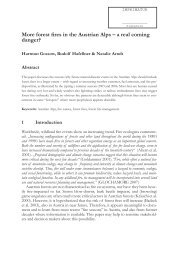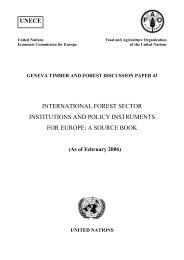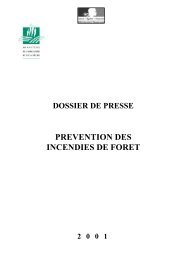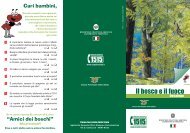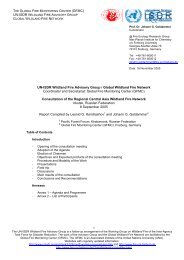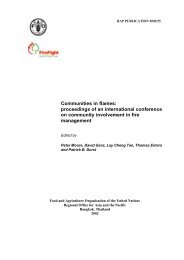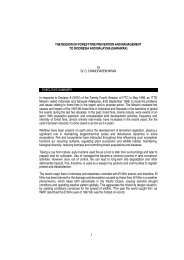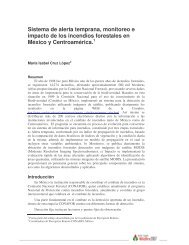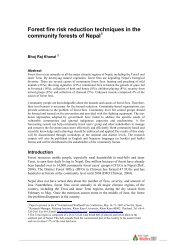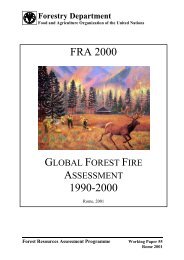Fire in Sweden ? History, Research, Prescribed Burning and Forest ...
Fire in Sweden ? History, Research, Prescribed Burning and Forest ...
Fire in Sweden ? History, Research, Prescribed Burning and Forest ...
Create successful ePaper yourself
Turn your PDF publications into a flip-book with our unique Google optimized e-Paper software.
International <strong>Forest</strong> <strong>Fire</strong> News (IFFN) No. 30 (January – June 2004, 80-83)<br />
<strong>Fire</strong> <strong>in</strong> <strong>Sweden</strong> – <strong>History</strong>, <strong>Research</strong>, <strong>Prescribed</strong> Burn<strong>in</strong>g <strong>and</strong> <strong>Forest</strong> Certification<br />
S<strong>in</strong>ce most of <strong>Sweden</strong> lies with<strong>in</strong> the boreal <strong>and</strong> boreo-nemoral zones, fire has, up until recently, also<br />
played a major role <strong>in</strong> shap<strong>in</strong>g the forests. Out of the total forested area of 23 million hectares (ha),<br />
only a few hundred thous<strong>and</strong> ha forest belongs to the temperate deciduous zone where presumably<br />
the rich hardwood forest composed by Fagus, Quercus, Frax<strong>in</strong>us, Ulmus, Tilia, <strong>and</strong> Acer sp. has been<br />
less <strong>in</strong>fluenced by fire <strong>in</strong> the past. Although most of our forests are shaped by fires it is not until the<br />
recent decade forest managers <strong>and</strong> public has become aware of this. <strong>Research</strong> about fire or rather<br />
research related to fire has <strong>in</strong>creased dramatically <strong>in</strong> the last years, largely catalysed by a grow<strong>in</strong>g<br />
concern for environmental issues.<br />
At present only a fraction of the forest l<strong>and</strong> burns annually (<strong>in</strong> the order of 0.017 - 0.0017%), from a<br />
few hundred hectares <strong>in</strong> wet years to a few thous<strong>and</strong> ha <strong>in</strong> a dry summer (max c. 5 000 ha). Most of<br />
the ignitions are today human caused but lightn<strong>in</strong>g ignitions can cause a substantial amount of the<br />
fires <strong>in</strong> dry years when periods of high pressure are followed by thunderstorms with little or no ra<strong>in</strong><br />
follow<strong>in</strong>g. The number of lightn<strong>in</strong>g ignitions follow a N-S <strong>and</strong> W-E gradient where the highest amount<br />
occur <strong>in</strong> the southeastern summerdry part of the country (<strong>in</strong> the order of 0.2 ignitions per 10 000 ha<br />
<strong>and</strong> year) <strong>and</strong> the lowest lightn<strong>in</strong>g ignition frequency <strong>in</strong> the high altitude northern forests (a factor 0.1<br />
or less than <strong>in</strong> the southeast) (Granström 1993).<br />
The burned area per year which allows conclusions on the fire frequency or the fire-return <strong>in</strong>terval<br />
today is very different from the past situation due to effective <strong>in</strong>direct <strong>and</strong> direct fire prevention <strong>and</strong><br />
suppression efforts. The network of forest roads is extremely dense, even <strong>in</strong> the north <strong>and</strong> allows for<br />
early attack by fire fire-fight<strong>in</strong>g crews. Accord<strong>in</strong>g to fire history studies (Kohh 1975; Zackrisson 1977;<br />
Engelmark 1984; Niklasson <strong>and</strong> Granström 2000) fires were occurr<strong>in</strong>g at 50-150 yr-<strong>in</strong>terval <strong>in</strong> the<br />
north <strong>and</strong> down to 20 yrs <strong>in</strong> the south (Page et al. 1997, Niklasson <strong>and</strong> Granström 2000, Niklasson<br />
<strong>and</strong> Drakenberg 2001). A very rough national average of the annually burned area of about 1.7 % of<br />
the total forest area is equivalent to a 58 yr-return <strong>in</strong>terval. <strong>Fire</strong> suppression became effective around<br />
1860-1880 over most of the country <strong>and</strong> s<strong>in</strong>ce then burned area dim<strong>in</strong>ished to a seem<strong>in</strong>gly steady<br />
level s<strong>in</strong>ce the 1950s. In the southern part suppression seems to have started less uniform <strong>and</strong><br />
generally earlier. The reasons beh<strong>in</strong>d the rapid decl<strong>in</strong>e <strong>in</strong> fire frequencies is somewhat debated<br />
although there are evidence for strong human impact on the fire regime from some regions (Niklasson<br />
<strong>and</strong> Granström 2000, Granström 2001). The rapid growth of organized forestry <strong>and</strong> exp<strong>and</strong><strong>in</strong>g timber<br />
<strong>in</strong>dustry over most of the country <strong>in</strong> the late 1800s should have had a major effect on this process.<br />
The long time of fire suppression <strong>in</strong> comb<strong>in</strong>ation with an <strong>in</strong>creas<strong>in</strong>gly <strong>in</strong>tense <strong>in</strong>dustrial forestry has<br />
had negative consequences for many species. While the loss of old trees must be ascribed more to<br />
forestry than fire suppression, the absence of fire has pushed several hundred of fire-adapted <strong>and</strong> firerequir<strong>in</strong>g<br />
species, predom<strong>in</strong>antly <strong>in</strong>vertebrates, from be<strong>in</strong>g common to rare or even ext<strong>in</strong>ct <strong>in</strong> the<br />
country (Ahnlund <strong>and</strong> L<strong>in</strong>dhe 1992, Ehnström, Långström et al. 1995, Wikars 1997). A few of these<br />
species are strictly dependent on fire per se while the major part of this group depend on structures<br />
<strong>and</strong> processes that ma<strong>in</strong>ly fires provided <strong>in</strong> the past such as: openness/sun-exposure, dead wood,<br />
damaged trees with lowered vitality, fire scars, burnt ground. Another strongly negative effect from the<br />
comb<strong>in</strong>ation of forestry <strong>and</strong> fire suppression is the lack of seral stages dom<strong>in</strong>ated by deciduous trees<br />
such as Betula, Populus, Salix. The reproduction from seeds of Populus <strong>and</strong> Salix is strongly<br />
promoted by fires <strong>and</strong> is now a rather rare event. The flagship species white-backed woodpecker<br />
Dendrocopus leucotos is now on the verge to ext<strong>in</strong>ction <strong>in</strong> <strong>Sweden</strong> be<strong>in</strong>g conf<strong>in</strong>ed to older deciduousdom<strong>in</strong>ated<br />
forest, typically of fire orig<strong>in</strong>. Only a hundred years ago this bird was common all over the<br />
country.<br />
Although the awareness has <strong>in</strong>creased dramatically among foresters <strong>and</strong> public about fire, this has so<br />
far very little been turned <strong>in</strong>to action when it comes to us<strong>in</strong>g fire as a tool. Although the structures,<br />
substrates <strong>and</strong> effects of fire has <strong>in</strong>fluenced the design of alternative management regimes<br />
(Angelstam 1998) the <strong>in</strong>corporation of fire is hampered by a lack of practitioners, anxiety for loos<strong>in</strong>g<br />
control of burns <strong>and</strong> a lack of resources. In fact, accord<strong>in</strong>g to the Swedish certification criteria under<br />
the <strong>Forest</strong> Stewardship Council as much as 5% of the annual clear-cut area should be burned. This is
hardly accomplished at present, <strong>and</strong> these burn<strong>in</strong>gs typically lack from a species-oriented view<br />
result<strong>in</strong>g <strong>in</strong> superficial burn<strong>in</strong>g of the organic layer but high tree layer mortality (Granström 2001, pers<br />
obs.). The burn<strong>in</strong>g for regeneration purposes had a renaissance <strong>in</strong> the period 1950-1970 (annually on<br />
the order of 10 000 ha) but ended rather abruptly due ma<strong>in</strong>ly to rapidly grow<strong>in</strong>g labour costs <strong>and</strong><br />
rationalization of management systems.<br />
Figure 1. <strong>Prescribed</strong> burn<strong>in</strong>g accord<strong>in</strong>g to the certification st<strong>and</strong>ards <strong>in</strong> June<br />
2001 on former state forest l<strong>and</strong> <strong>in</strong> southern <strong>Sweden</strong>. High <strong>in</strong>tensity, often<br />
mortal to left-beh<strong>in</strong>d trees, due to volum<strong>in</strong>ous slash <strong>and</strong> ignition pattern, is a<br />
common picture <strong>in</strong> these type of fires. For large forest owners, prescribed fire<br />
is required on 5% of the annual clear-cut area to meet the FSC certification<br />
st<strong>and</strong>ards. See:<br />
http://www.fsc-sweden.org/gron/Swedish%20FSC-st<strong>and</strong>ard1.html#6.4
Figure 2. The effects of the severe <strong>and</strong> dramatic fire of 1999 <strong>in</strong> Tyresta<br />
National Park attracts many field visitors. However, accord<strong>in</strong>g to tree r<strong>in</strong>g<br />
evidence such high-mortality burns were rare <strong>in</strong> the past. Up until the late<br />
1600s the area burned every 30 years by low-<strong>in</strong>tensity fires where after<br />
almost no fires occurred until now.
<strong>Fire</strong> research <strong>in</strong> <strong>Sweden</strong> is ma<strong>in</strong>ly concentrated to Umeå <strong>in</strong> the north with studies on succession, fire<br />
behaviour, <strong>and</strong> fire history (Granström, Schimmel, Niklasson, Zackrisson, L<strong>in</strong>der <strong>and</strong> others), plantplant<br />
<strong>in</strong>teractions, ecosystem function<strong>in</strong>g (Zackrisson, Nilsson, Jäderlund), paleoecology (Segerström,<br />
Hörnberg). Uppsala has a strong tradition <strong>in</strong> entomology (Wikars, Ehnström, Weslien). In southern<br />
<strong>Sweden</strong>, some paleoecological research has been done <strong>in</strong> the past (Bradshaw, Hannon, L<strong>in</strong>dbladh)<br />
but very little other research. <strong>Fire</strong> history studies has just started (Niklasson) <strong>and</strong> pilot studies <strong>in</strong> fire<br />
behaviour/flammability (Niklasson <strong>and</strong> others). A lot of the research <strong>in</strong> other fields of ecology can be<br />
ascribed to fire or has fire a common denom<strong>in</strong>ator. It is out of the scope here.<br />
IFFN Contribution by<br />
Mats Niklasson<br />
Southern Swedish <strong>Forest</strong> <strong>Research</strong> Centre<br />
Swedish University of Agricultural Sciences, SLU<br />
P.O. Box 49<br />
230 53 Alnarp<br />
<strong>Sweden</strong><br />
Tel: +46-40-415199<br />
Fax: +46-40-465363<br />
e-mail: mats.niklasson@ess.slu.se<br />
Anders Granström<br />
Department of <strong>Forest</strong> Vegetation Ecology<br />
Swedish University of Agricultural Sciences, SLU<br />
901 83 Umeå<br />
<strong>Sweden</strong><br />
Fax: +46-90-78-66612<br />
Tel: +46-90-78-65889<br />
e-mail: <strong>and</strong>ers.granstrom@svek.slu.se<br />
References<br />
Ahnlund, H. <strong>and</strong> A. L<strong>in</strong>dhe, 1992. Hotade ved<strong>in</strong>sekter i barrskogsl<strong>and</strong>skapet- några synpunkter utifrån<br />
studier av sörmländska br<strong>and</strong>fält, hällmarker och hyggen. Entomologisk Tidskrift 113 (4), 13-23.<br />
Angelstam, P. K., 1998. Ma<strong>in</strong>ta<strong>in</strong><strong>in</strong>g <strong>and</strong> restor<strong>in</strong>g biodiversity <strong>in</strong> European boreal forests by<br />
develop<strong>in</strong>g natural disturbance regimes. J. Vegetation Sci. 9, 593-602.<br />
Ehnström, B., B. Långström, et al., 1995. Insects <strong>in</strong> burned forests- forest protection <strong>and</strong> faunal<br />
conservation (prelim<strong>in</strong>ary results)." Entomologica Fennica 6, 109-117.<br />
Engelmark, O., 1984. <strong>Forest</strong> fires <strong>in</strong> Muddus National Park (northern <strong>Sweden</strong>) dur<strong>in</strong>g past 600 years.<br />
Canadian J. Botany 62, 893-898.<br />
Granström, A., 1993. Spatial <strong>and</strong> Temporal variation <strong>in</strong> lightn<strong>in</strong>g ignitions <strong>in</strong> <strong>Sweden</strong>. J. Vegetation<br />
Sci. 4, 737-744.<br />
Granström, A., 2001. <strong>Fire</strong> Management for Biodiversity <strong>in</strong> the European Boreal <strong>Forest</strong>. Sc<strong>and</strong><strong>in</strong>avian<br />
J. <strong>Forest</strong> Res. Suppl. 3, 62-69.<br />
Kohh, E., 1975. Studier över skogsbränder och skenhälla i älvdalsskogarna. (A study of fires <strong>and</strong> hard<br />
pan <strong>in</strong> the forests of Älvdalen). Svenska Skogsvårdsfören<strong>in</strong>gens Tidskrift 34: 481-512 (<strong>in</strong> Swedish).<br />
Niklasson, M. <strong>and</strong> B. Drakenberg, 2001. A 600-year tree-r<strong>in</strong>g fire history from Kvill National Park,<br />
southern <strong>Sweden</strong> - implications for conservation strategies <strong>in</strong> the hemiboreal. Biological Conservation<br />
101, 63-71.
Niklasson, M. <strong>and</strong> A. Granström, 2000. Numbers <strong>and</strong> sizes of fires: Long term trends <strong>in</strong> a Swedish<br />
boreal l<strong>and</strong>scape. Ecology 81, 1496-1499.<br />
Page, H.D., M. Niklasson, S. Källgren, A. Granström und J.G. Goldammer, 1997. Die Feuergeschichte<br />
des Nationalparkes Tiveden (Schweden). E<strong>in</strong>e kulturhistorische und dendrochronologische<br />
Untersuchung. Forstarchiv 68, 43-50.<br />
Wikars, L.-O., 1997. Effects of forest fire <strong>and</strong> ecology of fire-adapted <strong>in</strong>sects. Department of Zoology,<br />
Uppsala University: 35.<br />
Zackrisson, O., 1977. Influence of forest fires on the North Swedish boreal forest. Oikos 29, 22-32.





